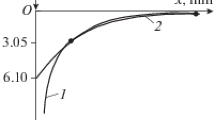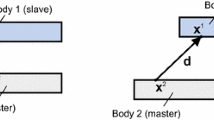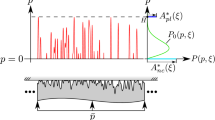Abstract
Solutions to contact problems are important in mechanical as well as in civil engineering, and even for the most simple problems there is still a need for research results. In the present paper we suggest an alternative finite element procedure and by examples show the need for more knowledge related to the compliance of contact surfaces. The most simple solutions are named Hertz solutions from 1882, and we use some of these solutions for comparison with our finite element results. As a function of the total contact force we find the size of the contact area, the distribution of the contact pressure, and the contact compliance. In models of finite size the compliance depends on the flexibility of the total model, including the boundary condition of the model, and therefore disagreement with the locally based analytical models is expected and found. With computational contact mechanics we can solve more advanced contact problems and treat models that are closer to physical reality. The finite element method is widely used and solutions are obtained by incrementation and/or iteration for these non-linear problems with unknown boundary conditions. Still with these advanced tools the solution is difficult because of extreme sensitivity. Here we present a direct analysis of elastic contact without incrementation and iteration, and the procedure is based on a finite element super element technique. This means that the contacting bodies can be analyzed independently, and are only coupled through a direct analysis with low order super element stiffness matrices. The examples of the present paper are restricted to axisymmetric problems with isotropic, elastic materials and excluding friction. Direct extensions to cases of non-isotropy, including laminates, and to plane and general 3D models are possible.
Similar content being viewed by others
References
Budynas RG (1999) Advanced strength and applied stress analysis. Berkshire, UK: McGraw-Hill, second edi. 935 pp
Gladwell GML (1980) Contact problems in the classical theory of elasticity. Alphen aan den Rijn, The Netherlands: Sijthoff and Noordhoff. 716 pp
Hertz H (1882) Über die berührung fester Körper. Journal für die reine und angewandte Mathematik 92:156–171
Johnson KL (1987) Contact mech. Cambridge, UK: Cambridge University Press. 452 pp
Norton RL (2000) Machine design - an integrated approach. New Jersey 07458, USA: Prentice-Hall, second edition. 1078 pp
Pedersen NL (2004a) Optimization of holes in plates for control of eigenfrequencies. Struct. Multidisc. Optim. 28(1):1–10
Pedersen P (2004b) On shrink fit analysis and design. Compu. Mech. 1–14. (to appear)
Timoshenko S, Goodier JN (1951) Theory of elasticity. Tokyo, Japan: McGraw-Hill/Kogakusha, second edition. 506 pp
Wriggers P (2002) Comput. contact mech. Chichester, UK: Wiley. 441 pp
Zhang HW, He SY, Li XS, Wriggers P (2004) A new algorithm for numerical solution of 3D elastoplastic contact problems with orthotropic friction law. Comput. Mech. 34:1–14
Author information
Authors and Affiliations
Rights and permissions
About this article
Cite this article
Pedersen, P. A Direct analysis of elastic contact using super elements. Comput Mech 37, 221–231 (2006). https://doi.org/10.1007/s00466-005-0707-0
Received:
Accepted:
Published:
Issue Date:
DOI: https://doi.org/10.1007/s00466-005-0707-0




